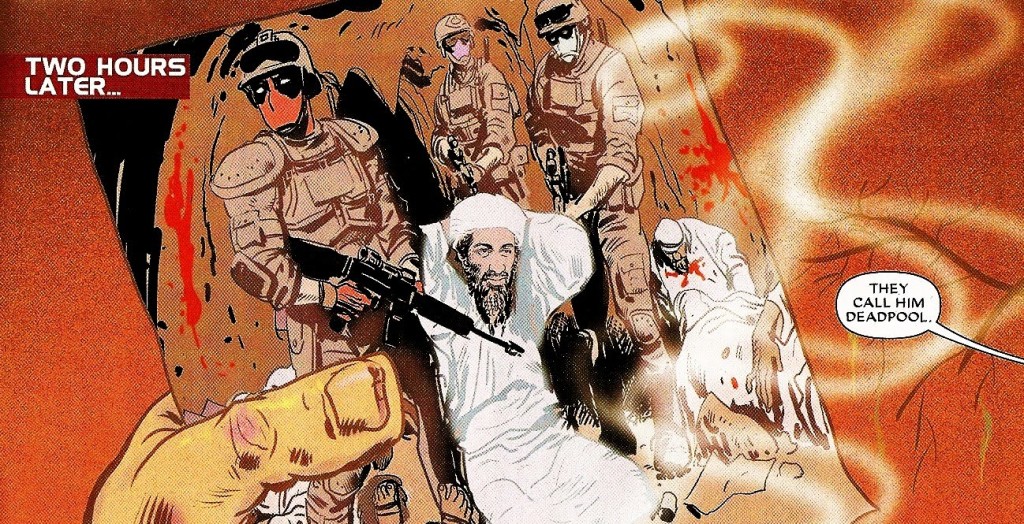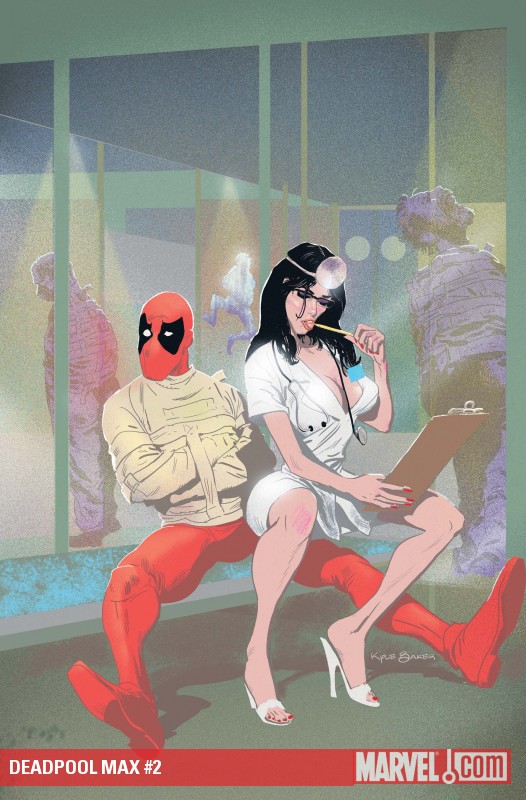Deadpool MAX 1-2
Reviewed by Richard Baez 01-Dec-10
Deadpool MAX, the inevitable “but now he can say ‘fuck'” iteration of Spider-Man-with-pouches. With David Lapham on scripting chores and Modern Master Kyle Baker on art – both idiosyncratic cartoonists with little aversion to journeyman dalliances, what rough beast will emerge?
Ah, the latest Deadpool title. When corporate monoliths cling ever tighter to their comic imprints, with grips similar to a child clinging to a beloved teddy-bear, and next week will see 793 Thor titles headed to your comics shop, all timed to release their trades just at the cusp of the summer movie season, its presence is heartening. When the Big Two release titles with all the calculation of chess pieces, we can applaud the fact that there is still a role for clumsy supply and demand to play and that, amid that applause, the sound of one hand clapping is the invisible hand of the market. Deadpool, Deadpool Team-Up, Prelude to Deadpool Corp, Deadpool Romance... in the words of your local retailer: “This shit sells.”
Mind you, barring that issue of Amazing Spider-Man that Eric Canete drew a year or so back, my knowledge of Deadpool is limited to early issues of X-Force, that sleeper cell opening salvo in what we would all soon know as the Image Revolution (Mike Mignola art on a Rob Liefeld story – it happened!). Despite my ignorance, I’m reasonably sure that those tales are necessary stepping stones in the current continuity, that fight with the mysterious dude with the flying cyborg hand who had mysterious ties to Cable’s past in X-Force #2 enshrined in the Merc With A Mouth’s mythology with the weight of the death of Uncle Ben or Tony Stark’s bouts with the bottle – on such foundations are icons made!
Of course they needn’t necessarily be so for Deadpool MAX, the inevitable “but now he can say ‘fuck'” iteration of Spider-Man-with-pouches; the MAX line traditionally reserves the right to adopt or neglect the constraints of Marvel continuity proper at the creative team’s discretion, lest the tangled web of consequence underlying any pre-existing corporate property clash too strongly with the presence of frontal nudity or viscera. With David Lapham on scripting chores and Modern Master Kyle Baker on art – both idiosyncratic cartoonists with little aversion to journeyman dalliances (Lapham’s Young Liars remains fresh in the memory, an intermittently potent satire on globalization via the scrim of indie youth culture circa 2001 that was quite allergic to narrative stabilization, and pondering Baker’s resume remains a distinct pleasure in of itself) – what rough beast will emerge?
Well, on one level, a work that moves and feels exactly like you’d expect. Two issues in, Deadpool MAX is very much a blunt object, with every page intent upon ensuring that the large MAX logo up front is earned, dammit. And it probably wouldn’t be presumptuous on the part of the reader to see the meticulously rendered scatological extreme placed three pages into the first issue as a statement of intent on the part of the creators – after all, sex and violence needn’t be the only fields at play. So, yes – heads will be sliced through, decapitated and squashed via a swift single headbutt (head injury being a theme of the first issue, titled, aptly, “Heads”); limbs will be rent asunder via uber-ninja swoops and organs will be harvested; brutal acts of sodomy will be implied and many an ass will be placed on gratuitous display. Funnily enough, there’s a distinct lack of frontal nudity on display – beyond a jolly extreme close-up of a penis upon which has been tattooed an image of Deadpool as an oni, there’s just one rather desultory shot of a nude obese woman; considering the context of this image – the setting being that hack screenwriter haven of a woman’s communal bath – it could be interpreted as a gleeful flouting of meat-and-potatoes fan service on the part of Lapham and Baker.
 Such details suggest a kinship with other MAX titles of this sort, wherein a Marvel Universe character, or recognizable alternate version thereof, is set loose on stories more befitting our own fallen world of anal sex and human trafficking (Alias by Bendis and Gaydos; Ennis and Aaron’s Punisher MAX). Deadpool MAX is decidedly different from that – Lapham and Baker seem to have studiously examined their central figure – the mentally unstable uber-assassin inclined to weak wisecracks – and have every aspect of the reality surrounding him fitted to suit, Deadpool being the most outre aspect in a framework primed for hysteria only by virtue of wearing ridiculous red tights. Midway through the first issue, there’s an introductory sequence which epitomizes this approach, a series of second-hand flashbacks wherein we glimpse our protagonist in scenarios iconic and silly: Deadpool standing guard over a captive Osama Bin Laden, clothed in stripper gear and mowing down gangsters while perched atop a giant novelty birthday cape (maybe a nod to the premiere issue of Ennis’ own Punisher MAX run), and that glorious tattooed penis mentioned above which neatly segues into an image of Our Man In Red straddling a big ol’ phallic nuclear warhead in North Korea and elegantly resolving any further trouble the U.S. might have from that arm of the Axis Of Evil. It’s all very much a piece with Baker’s own Iraq War satire Special Forces, where the autistic and the scantily clad fought the good fight side-by-side in a far off backward land against They Who Hate Our Freedom.
Such details suggest a kinship with other MAX titles of this sort, wherein a Marvel Universe character, or recognizable alternate version thereof, is set loose on stories more befitting our own fallen world of anal sex and human trafficking (Alias by Bendis and Gaydos; Ennis and Aaron’s Punisher MAX). Deadpool MAX is decidedly different from that – Lapham and Baker seem to have studiously examined their central figure – the mentally unstable uber-assassin inclined to weak wisecracks – and have every aspect of the reality surrounding him fitted to suit, Deadpool being the most outre aspect in a framework primed for hysteria only by virtue of wearing ridiculous red tights. Midway through the first issue, there’s an introductory sequence which epitomizes this approach, a series of second-hand flashbacks wherein we glimpse our protagonist in scenarios iconic and silly: Deadpool standing guard over a captive Osama Bin Laden, clothed in stripper gear and mowing down gangsters while perched atop a giant novelty birthday cape (maybe a nod to the premiere issue of Ennis’ own Punisher MAX run), and that glorious tattooed penis mentioned above which neatly segues into an image of Our Man In Red straddling a big ol’ phallic nuclear warhead in North Korea and elegantly resolving any further trouble the U.S. might have from that arm of the Axis Of Evil. It’s all very much a piece with Baker’s own Iraq War satire Special Forces, where the autistic and the scantily clad fought the good fight side-by-side in a far off backward land against They Who Hate Our Freedom.
As is, Deadpool MAX is “A MAD Look At Modern Superheroes”, with Deadpool in lieu of Superduperman but big-ass and in color, y’know? There’s nary any lip service to the ideal of heroism, with Deadpool instead a post Ellis/Millar garish government spook – an unpredictable force of will who pinballs his way through an environment, with bad barbs and swords slashing all the while, until the job gets done. Ultra-violent satire and slapsick ensue. I’m not sure whether mental hospitals get much play in in-continuity Deadpool (maybe just sheer exhaustion from appearing in all those titles?), but they’re certainly a presence here, a new one for every issue – perfect for any number of Alfred E. Neuman punchlines.
Baker’s art, especially in the first issue, does bear some comparison with Ariel Olivetti’s more recent work, which makes some sense in that they’re both mainstream artists prone to caricature who’ve integrated a digital aesthetic with a cartooning sensibility – specifically, sensibilities which place a premium on facial features and body language. Beyond their differing approaches to color and texture – Olivetti’s characters always come prepackaged with a glossy more-real-than-real sheen that both meshes quite nicely with the frequent photorealist backgrounds and ensures the comic will come in handy should you ever find yourself without a flashlight while Baker flattens everything on the page via a very basic color palate and the frequent suggestion of a proscenium arch just beyond the edges of many a panel (see also: Frank Quitely) – Olivetti’s figures always seem to fall prey to the demands of the genre, so impressive in their bulk and musculature that you can’t help but be surprised the bullets and swords they’re so frequently dodging don’t just bounce off or the characters can actually move and Baker’s figures, however gleefully he adopts those exaggerated physiques, retain their unstatuesque vulnerability – you will believe that that headbutt can squish.
The second issue picks up some considerable brio, with Baker’s pure cartooning absolutely gorgeous against simple near-abstract backgrounds. At times, he seems to be making an exuberant gallop through the ghosts of all the MAD greats, a little Kurtzman here, a dash of Jack Davis there, along with many a dead-on Mort Drucker – that reference a few paragraphs up wasn’t just an attempt at a blurb – climaxing in a pretty brutal take-down that looks like an appropriation of Sergio Aragones, except I don’t think Groo ever ripped a guy’s arm off and then strangled him with it, but then again I haven’t gotten around to Groo: Hell On Earth. The flashback sequences interspersed all throughout take on another style, midlevel pov shots approximating a child’s view, ghastly adolescence rendered with every object a pure color of the spectrum. It’s all a wonder to behold.
There’s not much like that in current mainstream comics, but hey, I hear Brendan McCarthy’s got a Judge Dredd thing out right now and those Marcos Martin Amazing Spider-Man issues are always swell.If I may commit the commentator’s sin and muse upon the item at hand, I do think it could be something very interesting indeed. If on the off chance this corporate property gets some proper love and care, water and sunlight at the proper intervals, well just imagine – a top flight cartoonist in tandem with a writer who knows how to invest a work with free-wheeling momentum and unpredictability working at a long form work of satire with every element pitched to the highest volume possible. Kinda like Bakune Young, maybe? It could be something. Sure it’s tremendously unlikely for any number of reasons – the incredibly conservative audience just ready to point their thumb downwards and see slaughter in the pits below, the sheer foolhardiness of success with something you don’t own… that’s a mighty set of obstacles.
Two issues in, though, just as its potential is showing itself, it’s alright.
Tags: David Lapham, Deadpool, Kyle Baker, Marvel
Hate to be the fella who comments on his own post, but damn, I suck.
Of course they needn’t necessarily be so for Deadpool MAX, the inevitable “but now he can say ‘fuck’” iteration of Spider-Man-with-pouches
COMPARE TO:
I’ve stopped counting Deadpool series and side-projects and cameos and the like, but I can’t imagine a we-can-say-fuck-now take on the character won’t be sort of worth peering at
As seen here.
The agony of influence!